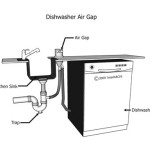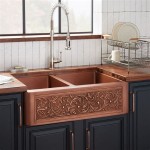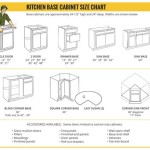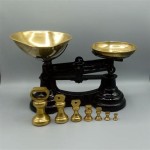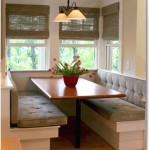How to Organize Kitchen Cabinets for Maximum Efficiency
Organizing kitchen cabinets effectively is a key component to maintaining a functional and efficient culinary workspace. A well-organized kitchen not only saves time and effort when preparing meals but also promotes a more pleasant and less stressful environment. The arrangement of items within cabinets impacts overall kitchen flow and accessibility. This article provides a comprehensive guide on how to optimize cabinet organization for maximum efficiency.
1. Decluttering and Inventory Assessment
The initial stage of cabinet organization involves a thorough decluttering process. Remove all items from the cabinets, placing them on countertops or tables. This provides a clear visual of the existing inventory and allows for a comprehensive assessment of what needs to be retained, donated, or discarded. Examine each item individually, considering its frequency of use, functionality, and overall condition.
Begin by discarding any expired food items, broken appliances, or duplicate tools. Items that are rarely used, such as specialized kitchen gadgets or serving dishes used only for specific holidays, can be considered for donation or storage in a less accessible area of the home. Evaluate the condition of cookware and bakeware, discarding any items that are significantly damaged or no longer perform adequately. Consider consolidating similar items, such as mixing bowls or measuring cups, to eliminate duplicates.
After decluttering, categorize the remaining items based on their usage. Common categories include cookware, bakeware, food storage containers, pantry staples, spices, small appliances, and serving ware. This categorization will inform the subsequent organization process, ensuring that items are stored in logical and accessible locations. Create an inventory list, either physical or digital, of the items that will be returned to the cabinets. This list can be used for future reference, making it easier to identify items that are needed or to avoid unnecessary purchases.
Cleaning the empty cabinets is an essential step before reorganizing. Wipe down the shelves and interiors with a damp cloth and mild detergent to remove any dust, crumbs, or spills. Consider using shelf liners to protect the cabinet surfaces and prevent items from sliding. Shelf liners can also add a decorative touch to the cabinets.
2. Optimizing Cabinet Layout and Storage Solutions
The next step is to strategically arrange the items within the cabinets based on their frequency of use and proximity to relevant work areas. The goal is to create a system that maximizes accessibility and minimizes unnecessary movement during food preparation. Items that are used most frequently should be placed in the most easily accessible areas, such as lower shelves or cabinets near the primary workstation. Less frequently used items can be stored on higher shelves or in the back of cabinets.
Consider the proximity of items to the areas where they will be used. For instance, pots and pans should be stored near the stovetop, while dishes and glasses should be located near the dishwasher or dining area. Baking supplies, such as flour, sugar, and mixing bowls, should be grouped together near the baking area. Spices should be organized near the stovetop for easy access during cooking.
Utilizing storage solutions such as shelf organizers, drawer dividers, and cabinet door racks can significantly enhance cabinet organization. Shelf organizers can create vertical space, allowing for the storage of more items within a single cabinet. Drawer dividers can keep utensils, cutlery, and other small items neatly separated and prevent them from becoming disorganized. Cabinet door racks are ideal for storing pot lids, spices, or cleaning supplies.
Vertical dividers are beneficial for organizing baking sheets, cutting boards, and platters. These dividers prevent items from stacking on top of each other, making it easier to retrieve them without having to move other items. Lazy Susans or turntables are effective for organizing spices, condiments, or canned goods, allowing for easy access to items stored in the back of the cabinet. Clear storage containers can be used to store dry goods, such as pasta, rice, and cereal, keeping them fresh and organized.
When storing food items, adhere to the principles of FIFO (First In, First Out). Older items should be placed in front of newer items to ensure that they are used before they expire. Regularly check the expiration dates of food items and discard any expired products to prevent spoilage and waste. Labeling containers with their contents and expiration dates can further enhance organization and prevent confusion.
3. Maintaining and Adapting the Organization System
Effective cabinet organization is not a one-time task; it requires ongoing maintenance and adaptation to ensure that the system remains functional and efficient. Regularly review the contents of the cabinets, removing any items that are no longer needed or used. This prevents clutter from accumulating and maintains the overall organization of the space.
After each use, return items to their designated locations. This prevents clutter from building up and ensures that items are easily accessible when needed. Make it a habit to put away dishes, cookware, and utensils immediately after washing them. This prevents them from piling up on countertops or in the sink, contributing to a cluttered kitchen environment.
Periodically reassess the organization system to identify areas that can be improved. As cooking habits and dietary needs change, the organization of the cabinets may need to be adjusted accordingly. For example, if there is an increase in the use of specific ingredients or appliances, consider reconfiguring the cabinet layout to make those items more accessible.
Involve all members of the household in maintaining the organization system. This ensures that everyone is aware of the designated locations for items and understands the importance of returning them to their proper places. Consider creating a visual guide or labeling the cabinets to make it easier for everyone to follow the organization system.
Consider the use of digital tools to aid in maintaining cabinet organization. Apps are available that can help track pantry inventory, manage shopping lists, and provide reminders for expiring food items. These tools can streamline the process of managing the contents of the cabinets and prevent food waste.
Adapting the organization system to accommodate seasonal changes can also be beneficial. During the holidays, for example, the cabinets may need to be rearranged to accommodate additional serving dishes, baking supplies, or specialty ingredients. After the holidays, the cabinets can be returned to their regular configuration.
By consistently implementing these strategies, it is possible to maintain a well-organized and efficient kitchen. The long-term benefits of effective cabinet organization include reduced stress, increased cooking efficiency, and a more enjoyable culinary experience. The key is to establish a sustainable system and to regularly review and adapt it to meet evolving needs.
4. Selecting Appropriate Organizational Tools
Choosing the correct organizational tools is paramount in optimizing cabinet spaces. The market offers a wide variety of solutions, and the selection should be based on the specific needs and configuration of the kitchen. Adjustable shelves are a versatile option, allowing for customization of the vertical space within the cabinet. These are particularly useful for accommodating items of varying heights, such as tall bottles or stacks of plates. Wire shelving can be used to maximize airflow and visibility, especially in pantries where dry goods are stored. They prevent items from being hidden in the back of the cabinet, ensuring that everything is easily seen and accessible.
Pull-out shelves are another effective solution for improving accessibility. These shelves slide out, bringing items stored in the back of the cabinet within easy reach. This is particularly useful for organizing pots, pans, and other heavy items that can be difficult to retrieve from deep cabinets. Drawer dividers are not limited to utensil drawers; they can also be used in larger drawers to organize cookware, bakeware, or even food storage containers.
Consider tiered shelving units for cabinets used to store spices or canned goods. These units elevate items in the back, creating a stepped effect that makes it easier to see and access all the contents. Over-the-door organizers are a practical solution for maximizing space on the inside of cabinet doors. They can be used to store cleaning supplies, spices, or small kitchen tools, freeing up valuable space on the main shelves.
Clear storage containers, available in various sizes and shapes, are essential for organizing dry goods and pantry staples. Transparent containers allow for easy identification of contents, while airtight seals help to keep food fresh and prevent pests. Invest in stackable containers to make the most of vertical space within the cabinets.
Magnetic strips are useful for storing knives, freeing up counter space and keeping them within easy reach. Mount the magnetic strip on the backsplash or inside a cabinet door. Pegboards can be installed inside cabinet doors or on walls to hang pots, pans, and other kitchen tools. This customizable system allows for flexible organization and keeps items readily accessible.
When selecting organizational tools, prioritize durability and ease of cleaning. Opt for solutions made from materials that are resistant to spills, stains, and moisture. Regularly clean the organizational tools to prevent the buildup of dust, crumbs, and other debris.
5. Addressing Common Cabinet Organization Challenges
Despite careful planning, various challenges can arise when organizing kitchen cabinets. One common issue is the presence of awkwardly shaped or sized items that are difficult to store efficiently. Solutions for this challenge include using adjustable shelves to accommodate different heights, employing vertical dividers to separate items, and utilizing specialized storage containers designed for unusual shapes.
Another challenge is maximizing space in small kitchens with limited cabinet capacity. In such cases, it is crucial to prioritize essential items and eliminate unnecessary duplicates. Utilize every available space, including the insides of cabinet doors and the areas above and below the main cabinets. Consider using wall-mounted shelves or racks to create additional storage space.
The accumulation of clutter is a persistent challenge that requires ongoing attention. Regularly declutter the cabinets, removing any items that are no longer needed or used. Establish a system for managing incoming items, such as a designated donation box or a policy of discarding an old item before purchasing a new one.
Maintaining organization over time can be difficult, especially in households with multiple occupants. To address this challenge, involve all members of the household in the organization process and establish clear guidelines for returning items to their designated locations. Label the cabinets and storage containers to make it easy for everyone to follow the system.
Limited accessibility to items stored in deep or high cabinets is another common issue. Pull-out shelves, lazy Susans, and step stools can improve accessibility in these areas. Consider storing less frequently used items in the most difficult-to-reach areas, reserving the easily accessible spaces for items that are used on a daily basis.
By proactively addressing these challenges and implementing appropriate solutions, it is possible to create and maintain a well-organized kitchen that meets the specific needs of the household.

How To Organize Kitchen Cabinets My Homier Home

How To Organize Your Kitchen Cabinets And Pantry Feed Me Phoebe

How To Organize Your Kitchen Cabinets In 3 Simple Steps Practical Perfection

30 Best Ideas To Organize Kitchen Cabinets

10 Best Kitchen Cabinet Organizers The Strategist

How I Organize My Kitchen To Make It More Functional Easy Maintain

Organize Your Kitchen Cabinets Using These Easy Tips Hsa
:max_bytes(150000):strip_icc()/crop-silvery-blue-cabinets-2000-70acba9f5faf464aa377714297d92570-a9692c7ba11e44ac86bc8f41c0a9fb42.jpg?strip=all)
How To Organize Kitchen Cabinets According Experts

How To Organize Kitchen Cabinets

Kitchen Cabinet Organization Your Ultimate Clutter Free Guide
Related Posts

